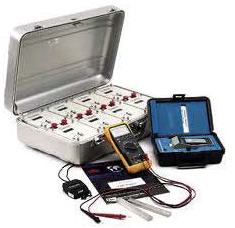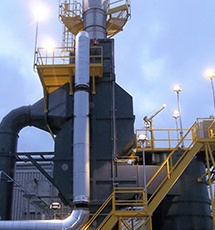Accurate measurement of airflow is a key part of properly sizing and selecting a new air pollution control device such as a thermal or catalytic oxidizer. Ongoing maintenance of existing thermal oxidizer’s should also include periodic air flow measurements. Usually, airflow measurement is a straightforward exercise, but special situations sometime occur that require alternatives. In this blog, we'll discuss the basics of airflow measurement and how to handle some problematic conditions.
The Basics
In theory, the volumetric air of any exhaust system can be determined using the fan curve of the primary blower in the system, but one should always check the actual air flow rates as well. The most common and easiest method of doing so is with a pitot tube. Pitot tubes allow a technician to determine gas velocity through differential pressure measurements, which then allows for the calculation of volumetric flow rates. USEPA Method 2 is the most commonly referenced technique for determining gas velocities. It is a relatively easy method to understand and perform.
Equipment to measure gas velocities by pitot tube is available for purchase or rent from a number of vendors and is relatively inexpensive for most applications. Emission measurement contractors can also perform the work.

Disturbed or Cyclonic Flow
Using a pitot tube to measure gas velocity assumes that the airflow in a duct is laminar or near-laminar. When flow is disturbed or cyclonic, pitot tube measurements will not be accurate. The most common cause of disturbed flow is a sample point too near a bend, constriction, damper, or other feature that would cause the disturbance. The most common cause of cyclonic flow is the use of axial fans.
There a few techniques for remedying this kind of situation. Flow straighteners (baffles arranged in a checkerboard fashion) are sometimes used. Temporary stack extensions are also appropriate in certain situations. If all else fails, an experienced emissions measurement contractor can measure gas velocities in a disturbed or cyclonic location by performing one of two techniques: the “3-D pitot” (USEPA Method 2F) or the “2-D pitot” (USEPA Method 2G).
Very Low Gas Velocities
Pitot tube accuracy begins to drop off at gas velocities of around 10 feet per second (fps) and should never be used when gas velocities are less than 5 fps. In these situations, there are several potential options.
If the duct or pipe is small enough, installation of a volume flow meter – Roots-type meters and turbine meters being the most common – can provide the answer. Orifice plates are another option in this situation. If all else fails, hot wire or vane anemometers can be used, although data gathered using an anemometer should be treated carefully, as the accuracy of these devices may not be ideal.
Very High Gas Velocities
At very high gas velocities of approximately 75 fps or greater, a pitot tube may oscillate due to the pressure exerted by the rapidly moving gas, and those oscillations may affect the accuracy of the flowrate measurement. High velocities of this sort are most commonly found in the exhausts of internal combustion engines and combustion turbines.
Rather than measuring gas velocity in these types of sources, it is usually more accurate to calculate the volumetric flowrate by measuring the CO2 concentration in the exhaust gas and fuel flow rate over a given period of time. With those two data points in hand, an experienced emissions measurement company can then calculate the volumetric flow rate to a high degree of accuracy.
High Pressure and/or Toxic Gas Locations
Safely determining gas velocities using a pitot tube in high pressure ducts or ducts that contain dangerous amounts of toxic components is possible, but should only be performed by an experienced emissions measurement contractor when there is no alternative, after completion of a rigorous safety plan. Ultrasonic “clamp to the pipe” flow meters are a viable alternative in many of these situations.
Take Aways
For new equipment that requires clean air act operating permits:
Accurate measurement of airflow is a key when starting to evaluate VOC abatement equipment and applying for your new source air permit. For more information about permits, please download our ebook:
For ongoing maintenance of existing VOC abatement or NOx reduction equipment:
It is critical to take air flow measurements at least during yearly maintenance and equipment inspections. This step will help to ensure the permitted control device is operating to stated permitted levels. If out-of-range volumes are determined you can quickly make adjustments to ensure your operation is compliant. This also has immediate payback by ensuring your operations are not operating at excessive exhaust conditions which will help to lower your natural gas and electric useage.
If you're looking to implement a solution to measure airflow, we can help you find the method that works best for you, taking all of the issues mentioned above into account. Please contact us today!
Additional information: Important message for every operator with a clean air permit










